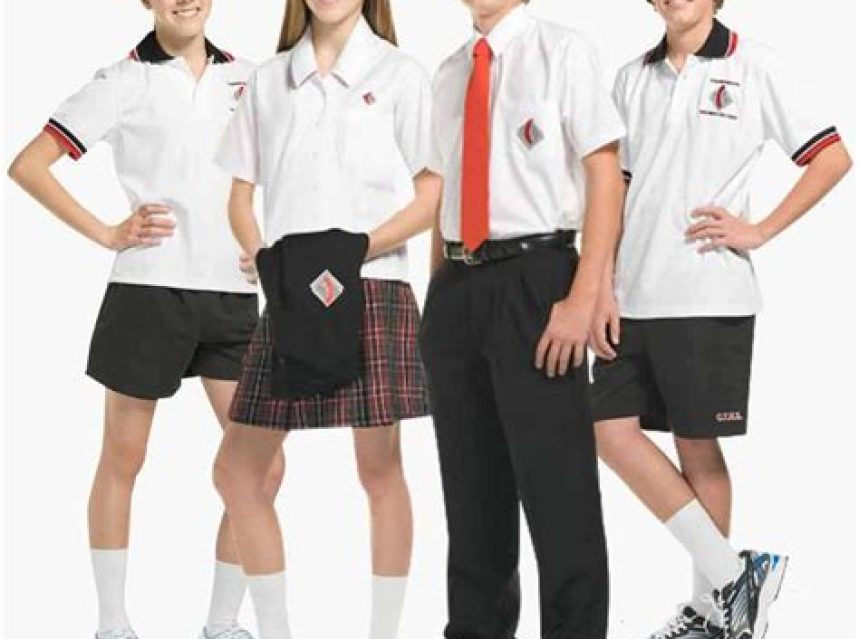Australian School Uniforms

Introduction:
School uniforms have long been a standard feature of educational institutions around the world, including Australia. This hallowed tradition has evolved over time, reflecting the diverse history and cultural nuances of the country. In this blog post, we will delve into the fascinating history of Australian school uniforms, exploring how they have developed from their early beginnings to the present day. We will also examine the purpose and benefits of these uniforms, along with the various design variations that exist across schools. Furthermore, we will delve into the ongoing debate surrounding school uniforms in Australia, and how they impact student behavior. Stay tuned as we unravel the multifaceted elements that shape the world of Australian school uniforms.
History of Australian school uniforms
The history of Australian school uniforms is a fascinating subject that showcases the evolution of educational dress codes in the country. School uniforms have a long and rich history in Australia, with their origins dating back to the early colonial era. During this time, uniforms were primarily worn by students in private and prestigious schools, serving as a symbol of status and professionalism. However, the concept of school uniforms gradually spread to public schools, and by the mid-20th century, they became more widespread across the nation.
In the early years, Australian school uniforms were heavily influenced by British traditions, reflecting the country’s colonial ties. Boys often wore tailored suits or blazers, paired with shorts and knee-high socks, while girls typically sported dresses or skirts with blouses. As the years went by, the design and materials of school uniforms evolved to accommodate changing fashion trends and societal norms.
With the rise of feminism in the 1970s and a greater focus on gender equality, schools started to adopt more gender-neutral uniforms. This shift led to the introduction of unisex clothing options, such as trousers for girls and skirts for boys, providing students with more choices that aligned with their personal preferences. Today, Australian school uniforms continue to evolve, incorporating modern fabrics, practical designs, and inclusive styles.
Benefits of School Uniforms:
- Improved Sense of Belonging: School uniforms help create a sense of unity and belonging among students, promoting a positive school culture and identity.
- Enhanced Focus on Learning: By removing the distraction of varied clothing styles, uniforms contribute to a more focused and conducive learning environment.
- Promotion of Equality: School uniforms ensure that all students, regardless of their socio-economic background, can dress consistently and feel equal among their peers.
Table: Variations in School Uniform Designs
| School Level | Typical Uniform Elements |
|---|---|
| Primary School | Polo shirts, shorts/pants, skirts/pinafores, and blazers |
| Secondary School | Button-up shirts, trousers, skirts, blazers, ties, and dresses |
| Tertiary Education | More relaxed dress codes, such as branded t-shirts or casual wear |
In conclusion, the history of Australian school uniforms is a testament to the changing social, cultural, and educational landscapes of the country. From their origins as symbols of prestige and professionalism, school uniforms have transformed into inclusive garments that foster a sense of identity and unity among students. As debates about the benefits and drawbacks of school uniforms continue, it remains clear that they play an integral role in shaping the educational experience and nurturing a positive learning environment for students across Australia.
Purpose and benefits of school uniforms
School uniforms have been a controversial topic for many years, with arguments on both sides of the debate. While some people believe that school uniforms restrict individuality and self-expression, others argue that they serve an important purpose and offer several benefits. In this blog post, we will explore the purpose and benefits of school uniforms, highlighting the positive aspects they can bring to educational institutions.
One of the main purposes of school uniforms is to create a sense of unity and belonging among students. When everyone is dressed in the same attire, it minimizes the socioeconomic differences and reduces the chances of students being singled out or bullied based on their clothing choices. School uniforms promote equality and foster a sense of community where students can focus on their studies and personal growth rather than their appearance.
Additionally, school uniforms can have a positive impact on student behavior. By wearing uniforms, students tend to develop a better understanding of discipline and respect for rules. The dress code creates a structured environment where students are more likely to behave appropriately and focus on their academic responsibilities. Moreover, uniforms eliminate the distractions and peer pressure that arise from keeping up with the latest fashion trends, allowing students to concentrate on their education.
- Improved Safety: School uniforms typically include specific colors or insignias that make it easier to identify students and ensure their safety both within the school premises and on field trips or excursions.
- Enhanced School Spirit: Wearing a uniform instills a sense of pride and belonging in students, contributing to a positive school atmosphere and fostering a sense of unity among classmates.
- Cost Savings: Uniforms can be more cost-effective for parents in the long run, as they eliminate the need for constantly purchasing new clothes following the latest fashion trends.
| Purpose | Benefits |
|---|---|
| To create a sense of unity and belonging among students. | Improved safety |
| To promote equality and minimize socioeconomic differences. | Enhanced school spirit |
| To instill discipline and respect for rules. | Cost savings for parents |
While school uniforms may have their critics, it is important to recognize the purpose they serve and the benefits they offer. By fostering a sense of unity, improving safety, enhancing school spirit, and promoting discipline, uniforms can contribute to creating a positive and conducive learning environment for students. Ultimately, the purpose and benefits of school uniforms extend far beyond the clothes themselves, helping to shape students’ character, behavior, and overall educational experience.
Variations in school uniform designs
School uniforms have been a longstanding tradition in many countries, including Australia. However, what many people may not realize is that there are various designs and styles of school uniforms. These variations in school uniform designs not only reflect the individuality of different schools, but they also allow students to express themselves while adhering to the school’s dress code guidelines.
One of the most common variations in school uniform designs is the choice of colors. While some schools opt for classic colors like navy blue or white, others may choose more vibrant hues such as red, green, or even purple. The color of a school uniform can symbolize the school’s identity and values. For example, a school that emphasizes tradition and discipline may opt for a more conservative color, while a school that values creativity and innovation may choose a more unconventional color palette.
In addition to colors, another aspect that varies in school uniform designs is the type of clothing item itself. While most schools require students to wear a standard polo shirt and trousers or skirt, some schools may allow variations such as different styles of collars, sleeve lengths, or even optional accessories like vests or blazers. These variations allow students to add their own personal touch to their uniforms, which can help foster a sense of ownership and pride in their school attire.
Furthermore, some schools go beyond the traditional shirt and trousers/skirt combination and incorporate unique elements into their uniform designs. This could include elements like patterned fabrics, unique button designs, or even specific accessories like hats or ties. These unique elements not only make the uniforms more visually appealing but also contribute to the overall identity and branding of the school.
- Colors: Reflect the school’s identity and values.
- Type of clothing: Different styles of collars, sleeve lengths, and optional accessories.
- Unique elements: Patterned fabrics, unique buttons, and specific accessories.
| Colors | Type of Clothing | Unique Elements |
|---|---|---|
| Reflect the school’s identity and values. | Different styles of collars, sleeve lengths, and optional accessories. | Patterned fabrics, unique buttons, and specific accessories. |
Debate on school uniforms in Australia
In Australia, the debate on school uniforms has been a long-standing discussion among educators, parents, and students. Supporters argue that uniforms promote a sense of belonging, unity, and discipline among students, while opponents claim that they restrict individuality and self-expression. This debate has sparked numerous conversations and studies, examining the pros and cons of implementing school uniforms in Australian educational institutions.
Proponents of school uniforms in Australia believe that they foster a sense of equality among students. Wearing the same attire eliminates the visible difference between students from various socioeconomic backgrounds, reducing the chances of discrimination based on clothing. Additionally, uniforms are believed to promote discipline and a positive learning environment by minimizing distractions caused by fashion trends or clothing brands.
On the other hand, opponents argue that school uniforms infringe upon students’ right to freedom of expression. They believe that uniforms stifle individuality and creativity, preventing students from expressing their unique personalities. In a country that values diversity, critics argue that school uniforms may hinder students’ ability to explore and embrace their identities.
Furthermore, some studies have been conducted to understand the impact of school uniforms on students’ academic performance and behavior. While some research suggests a positive correlation between uniforms and improved concentration and behavior, other studies indicate no significant difference. It is essential to note that many factors contribute to a student’s academic success, and uniforms alone cannot guarantee academic achievements.
- Uniforms foster a sense of belonging and unity among students.
- They promote a positive learning environment by minimizing distractions.
- Uniforms may infringe upon students’ right to freedom of expression.
- They can restrict individuality and self-expression.
- Research indicates mixed results on the impact of uniforms on academic performance and behavior.
With the ongoing debate on school uniforms in Australia, it is crucial to consider all perspectives and conduct further research to make informed decisions. As educators and policymakers strive to create inclusive learning environments, finding a balance between promoting unity and embracing diversity becomes paramount. Ultimately, the debate on school uniforms should focus on creating an environment that nurtures individuality while fostering a sense of community among students.
Impact of school uniforms on student behavior
Wearing school uniforms has been a long-standing tradition in many educational institutions around the world, including Australia. While some see it as a way to promote a sense of equality and discipline among students, others argue that it restricts individuality and self-expression. However, one aspect of school uniforms that often gets overlooked is their impact on student behavior. In this blog post, we will explore the different ways in which school uniforms can influence student behavior.
One of the primary purposes of school uniforms is to create a sense of belonging and unity among students. When everyone is dressed in the same attire, it reduces the visibility of social and economic differences, thus minimizing the chances of bullying and discrimination. Students are more likely to judge and evaluate each other based on their character and actions rather than their clothing choices. This sense of inclusivity can encourage positive behavior and foster a supportive environment within the school community.
Moreover, school uniforms eliminate the need for students to spend excessive time and energy on deciding what to wear each day. This saves valuable instructional time that would otherwise be wasted on discussions about fashion trends and individual styles. Instead, students can focus on their studies and engage more actively in classroom activities. With fewer distractions and reduced peer pressure to wear specific brands or styles, students may experience lower levels of stress and anxiety, leading to improved concentration and academic performance.
- School uniforms promote equality and discourage social discrimination.
- Wearing uniforms saves time and reduces distractions in the classroom.
- Uniforms can instill a sense of pride and belonging among students.
| Positive Impacts | Negative Impacts |
|---|---|
| Enhanced focus on academics | Restriction of individuality |
| Reduction in bullying | Resistance from students |
| Increase in school spirit | Added financial burden on families |
In conclusion, while there may be differing opinions on whether or not school uniforms are beneficial, their impact on student behavior cannot be ignored. School uniforms promote a sense of unity, equality, and inclusivity among students, reducing the chances of social discrimination and bullying. Additionally, uniforms save time and minimize distractions, allowing students to focus more on their studies. However, it is essential to address concerns regarding the restriction of individuality and the financial burden they may place on families. Overall, the impact of school uniforms on student behavior is a complex and nuanced topic that requires ongoing discussion and consideration.
Frequently Asked Questions
Question 1: What is the history of Australian school uniforms?
Australian school uniforms have a long history that dates back to the early 1800s. They were initially adopted by private schools to create a sense of uniformity and discipline among students. Over time, school uniforms became more common in both public and private schools across the country.
Question 2: What is the purpose and benefits of school uniforms?
The primary purpose of school uniforms is to promote a sense of belonging and unity among students. They create an equal playing field by eliminating the visible distinctions of social class and reduce the pressure to dress fashionably. School uniforms also help in instilling discipline, improving safety and security by making it easier to identify outsiders, and fostering a sense of pride in one’s school.
Question 3: What are the variations in school uniform designs?
School uniform designs in Australia vary depending on the school, region, and educational level. While most schools have a standard uniform consisting of shirts, skirts, trousers, and blazers, some may have specific requirements like ties, hats, or kilts. The colors and patterns also differ, with some schools opting for traditional styles, while others incorporate modern elements.
Question 4: What is the debate on school uniforms in Australia?
The debate on school uniforms in Australia revolves around the issues of individuality, expression, and cost. Critics argue that uniforms suppress students’ freedom of expression and restrict their individuality. They also highlight the financial burden on parents to purchase multiple sets of uniforms. On the other hand, proponents believe uniforms promote a sense of inclusivity and reduce peer pressure based on clothing choices.
Question 5: How do school uniforms impact student behavior?
Research suggests that school uniforms can positively influence student behavior. By eliminating the distractions caused by fashion competition and peer pressure, uniforms help students focus on their studies. Uniforms also promote a sense of professionalism, discipline, and respect among students, as they are seen as representatives of their schools. Additionally, uniforms contribute to a safer school environment by allowing easy identification of intruders.
Question 6: Are school uniforms mandatory in all Australian schools?
No, school uniforms are not mandatory in all Australian schools. While many private schools have strict uniform policies, public schools have more flexibility. Each school has its own dress code policy, allowing them to decide whether to implement uniforms. However, even in schools without mandatory uniforms, there is usually a dress code to maintain an appropriate and respectful appearance.
Question 7: Can students express their individuality despite wearing uniforms?
Yes, students can still express their individuality within the boundaries of school uniforms. Accessories such as badges, ties, hair accessories, and socks can allow students to add personal touches to their uniforms. Additionally, school activities and clubs provide opportunities for students to showcase their unique skills and interests outside of their uniformed appearance.



